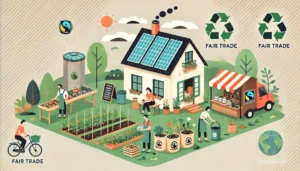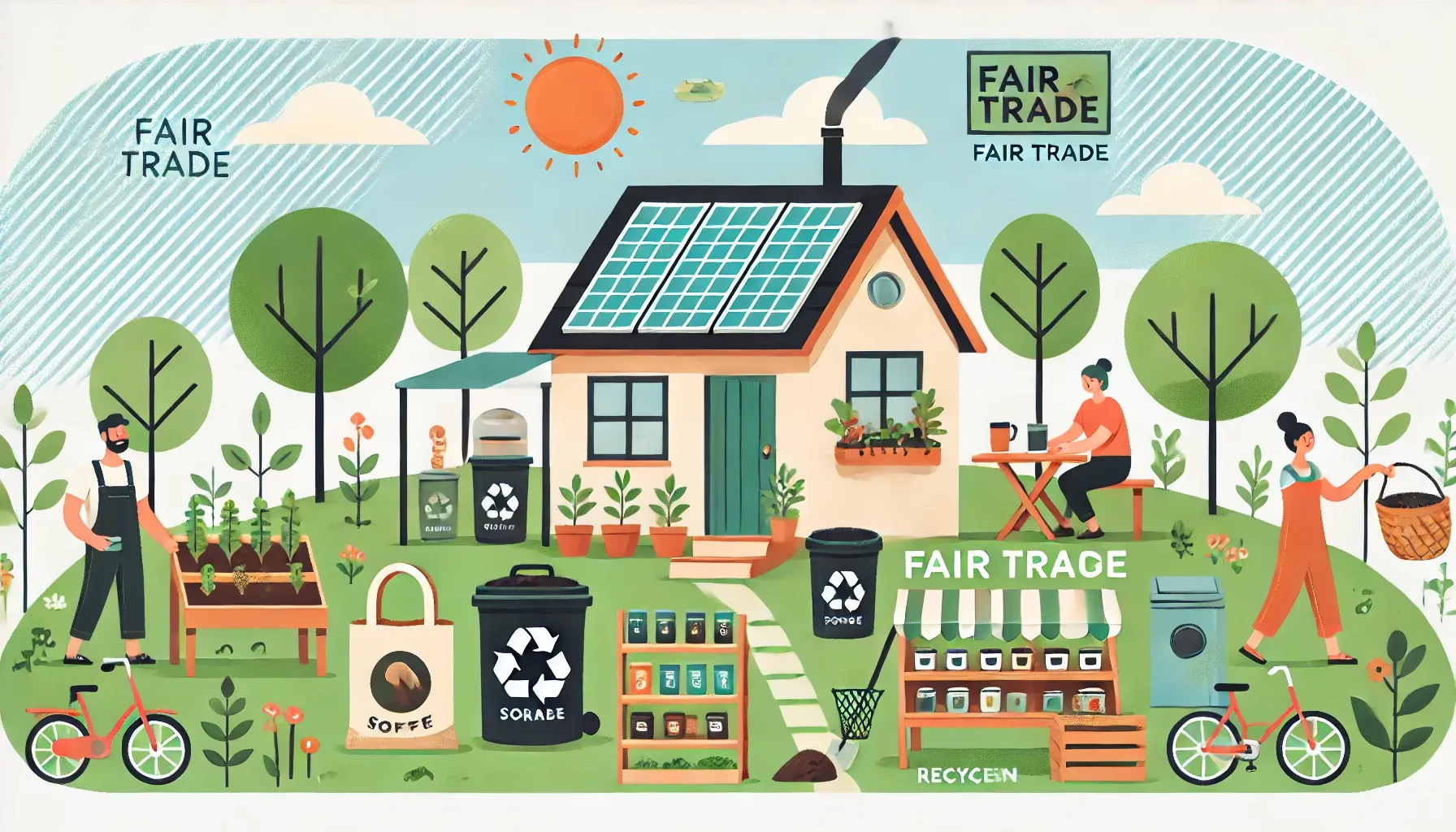Introduction
The idea of fair trade alongside environmentally friendly is leading the way in finding a sustainable future. There is an intention to make the world a more equitable place where economic, social, and environmental justice are in balance. They have a common ethos- they encourage ethical consumption, lessening the strain on our environment and supporting local community development. This deep dive examines how fair trade and eco-friendly living are not just a match made in heaven, but perfect partners for the new world that is coming.

Understanding Fair Trade
Fair trade is an international movement that supports better trading conditions and sustainability for producers in developing countries. The emphasis here is on employees earning decent wages, working in a conducive environment, and the responsible use of natural resources. All fair trade certified means is that it has been designated to meet certain standards for the social, economic, and environmental conditions in which it was procured.
Key Principles of Fair Trade
Living Wages: Making sure producers and laborers receive a living wage.
Safe Working Conditions: Ensuring a safe and healthy working environment.
Environmental Sustainability: Encouraging any farming and production tactics that are not harmful to the environment.
Community Development: A focus on investing the money in local communities to finance social and economic development initiatives.
Worker Empowerment: Promoting democratic decision-making and human rights.
The True Art of Sustainable Living
Eco-friendly living is also known as green living or sustainable living and refers to the lifestyle choices that we make in our everyday lives. This means limiting waste and energy use; using renewable resources such as solar rather than fossil fuels (unless you had a plan to capture carbon emissions); minimizing pollution. We must aim to live sustainably and responsibly upon this planet, thereby allowing for the well-being of generations yet unforeseen.
Principles of Eco-Friendly Living
Waste Reduction: Adopting methods such as recycling, composting, and minimizing single-use plastics.
Energy Conservation: Using energy-efficient appliances, consuming less power, and using renewable sources of the same.
Sustainable Sourcing: Products with designations such as sustainably sourced, sustainable materials (choose this by not using virgin materials), select companies that engage in eco-friendly practices.
Reduce Pollution: Use less harmful chemicals, make clean energy more important, and protect policies that keep the environment safe.
Conservation of Natural Resources: To conserve water sources, forests, and other ecosystems.
The Perfect Combination of Fair Trade and Eco-Friendly Living
Fair trade ideals encourage environmentally sound practices, so fair trading and eco-responsibility uniquely go hand-in-hand. They both aim to promote good practices for production and consumption, the maintenance of natural environments, and social justice. Here’s how they intertwine:
Shared Goals and Values
Ethical Consumption: Perhaps most evidently at this point, both fair trade and eco-friendly living promote ethical consumerism that enables consumers to take steps against polluting the environment while supporting sustainability and social justice ethical livelihood choices.
Promotion of Sustainable Practices: To eliminate or dramatically reduce emissions using practices that do not cause significant harm, depletion, and degradation.
Community and Worker Power: They both understand that the communities need to be better off in their lives, as well as worker power.
Mutual Benefits
Access to Larger Markets: Fair trade certification can be used to gain access in…by capturing market share people Trends humanity, receive treaty ForResource- this will send a return of socially commodities consumers.
Greater Consumer Awareness: When messages around fair trade and eco-responsible living are combined, consumers have the opportunity to understand not only that their choices do make a difference but how the implications of those decisions translate into dollars at checkout.
Reduce Your Carbon Footprint: Both fair trade certified and environmentally-friendly products contribute to a greener planet by having little or no damage on the environment during production, as well as no harmful labor practices.
Case Studies: Example of Successful Integration with Fair Trade and Eco-Friendly Practices
1. Patagonia
Patagonia is a leading outdoor clothing company that demonstrates how to use fair trade and sustainable practices throughout the business. Their products are made from sustainable materials like organic cotton and recycled polyester with a major recycling program in place for all their items. By the way, Patagonia is also at the forefront of fair trade – which means their workers are correctly compensated and do not work in unsafe environments. This has gained the company a following among eco-conscious consumers eager for new options from responsible suppliers.
2. Divine Chocolate
Divine Chocolate – Another UK-based company that is co-owned with cocoa farmers. It is a powerful example of how BeadforLife walks the line between fair trade and being environmentally friendly. It uses sustainably sourced cocoa and invests in community development projects that help farmers work their way out of poverty. In so doing, they support fair trade; and by promoting methods like agroforestry as well as organic farming, Divine Chocolate contributes to environmental sustainability.
3. Ten Thousand Villages
Ten Thousand Villages: This fair trade retailer has a lovely assortment of eco-friendly goods, from home decor to jewelry and personal accessories. They respectively pay a livable wage to artisans across the globe as well as supporting sustainable production practices. Ten Thousand Villages is dedicated to fair trade as well as an eco-conscious lifestyle and consumers are offered the chance of buying ethically made, environmentally friendly items.
Practical Steps for Consumers
Here are some specific steps individuals can take to start living more in line with fair trade and eco-friendly principles:
- Buy Fair Trade Certified Products
Look for fair trade certifications on coffee, chocolate, teabags, and clothes. Part of the certification guarantees fair wages, safe working conditions, and sustainability so part if not all these ingredients could be approved by The Fair Trade Federation or Social Accountability International.
- Support Eco-Friendly Brands
Buy from authentically sustainable companies. Opt for items made with organic, recycled, or sustainable materials.
- Reduce, Reuse, Recycle
Practice Minimalist consumption by reducing waste, reusing things, and recycling properly. But, compost your organic matter and reduce single-use plastics.
- Conserve Energy and Water
Make your home energy-efficient by using new appliances, LED bulbs, and adding renewable energies like solar panels. Volunteer to fix leaks, use water-saving devices, and reduce your daily needs.
- Educate Yourself and Others
Educate yourself about the consequences of your purchase in addition to raising awareness among others concerning fair trade and a green lifestyle. More generally, advocacy and awareness can move the needle on consumer behavior as well as corporate practices.
The Fair Trade and Green Living Outlook
With so much more enlightening going on out there about the state of society and our earth, it is almost inevitable that Fair Trade practices will continue to become ever more prevalent in global society. What to expect next (but not only).
- Increased Consumer Demand
Over time, as environmental issues and social justice become critical topics, consumers are seeking products in adherence to their own set of values. This increase will prompt more corporate fair trade and sustainable business practices.
- Technological Advancements
Technological advancements will make production more sustainable and facilitate the traceability of supply chains. Advancement renewable energy, biodegradable materials and sustainability in agriculture will help in achieving as well consumer respect for the fair trade goals.
- Tighter Regulations & Standards
Tighter regulations and standards on fair trade, slave labor/slavery may be needed in a growing population thanks to government or international organization forces plein (fines). You will make sure that companies follow ethical standards and a more sustainable world economy.
- The Power of Collaboration
Thousands of people are concentrating every day to make the details happen, and chasing it up one by one will be extremely inefficient. The power of collaboration is covered in today’s traveling style. Both the were economy and eco-friendly movements will be able to have a stronger together with fair trade products in play. Collaborations foster unity, amplifying voices and broadening perspectives to address global issues holistically.
- Holistic Approaches
The future will involve a combined strategy for sustainability that includes integration of fair trade and environmental ethos with wider efforts encompassing climate change, poverty reduction, and social justice. This will think systemically and recognize that these problems are linked.
Conclusion
By buying fair trade and living eco-consciously, we are not simply upholding trends – we are the antithesis of a livable future. In seeking to remedy these anthropologic problems that have come into focus in our lifetime, new movements such as B corporations and Corporate Social Responsibility (CSR) are born. We thus support millions of communities and families around the world as well as move ever closer toward a future where fair trade, environmental justice, and social equity are not things we just talk about but ways in which consumers, businesses, and even governments consciously live. When combined, the relationship between fair trade and living an eco-friendly life provides a potent route to equality fixated on sustainability all whilst ensuring that each purchase adds value in some way towards society as well as our natural environment.
